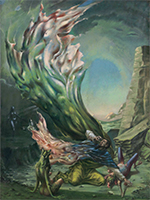Sequence 6
Term Paper
"The riddle of the universe I might solve if I had a mind to, he said,
but I prefer
the question to the answer. It serves men like us as a
bottomless pretext
for scholarly dialectic” (274).
Flann O'Brien's At-Swim-Two-Birds (1939)
Audience: literary critics intimately familiar with the Path 2 works you have read/viewed
Purpose: to demonstrate the validity of your debatable thesis, supported
by close, creative analysis of your group's Path 2 works
Voice: professional and formal (avoid 1st-person pronouns, contractions,
colloquial speech, etc.)
Essays should be 6-8 pages in length, and follow MLA guidelines for formatting, in-text citation, and creating appropriate citation entries in a separate Works Cited page. Use a Times New Roman, 12 pt font with 1" margins top, bottom, right and left (1" is not the default margin in Word, so you'll need to change it.) Papers are due, via email by Wed., June 12 at 11:59 p.m. You must complete the Path 2 group outline workshopping session during office hours before turning in your paper.
Your paper
should reflect an intimate familiarity with all of your Path 2 texts (both novel & your film). You have free
reign of topic: just be sure to construct a narrow argument,
supported closely by relevant textual detail. You may think the length provides
you the freedom to ramble: think again. Every sentence should be packed with
meaning, and each word used should be the most exact, powerful word possible
given its context. Your claims should explode off the page.
Possible approaches
might
involve analyses of voice, characterization, metaphor, tone,
identity, aesthetics,
faith, or philosophy. You can also approach your texts through a biographical, historical, or theoretical lens. Just insure that you choose a topic
you find compelling, shape an argument you can enjoy making, and support your claims with close readings of primary texts.
Also, be sure to incorporate two secondary sources, limiting yourself to literary criticism, biography, or historical analysis. Please do not build your paper atop other critics' arguments; if you use literary criticism, please use sources that provide opposition for your own argument. You may relegate references to these texts to the introduction or conclusion, or insert them throughout the body of your essay.
I encourage you to search the stacks and databases available through the Robert E. Kennedy Library as you look for secondary sources. You may draw on journal articles, book chapters, introductions to your novels, or professional online resources. I have a few authoritative biographies in my office, along with select critical texts tackling some of your authors' works; you are quite welcome to drop by, grab a book, and plop yourself on the office couch. Whatever sources you do use should be listed in your Works Cited page along with the novels you have read and film you watch, as well as whatever Path 1 texts you cite.
Topics might include but are by no means limited to:
term paper outline workshopping session (10%): students should study the points for reflection concerning week 7 as they prepare for their final office visit; this one-hour session will combine group discussion of your final Path 2 reading with discussion of each student's 2-3 page term paper outline (sent to everyone in the group--and Dr. M--via email prior to your group's conference). These sessions will occur between Mon., May 20 and Sat., May 25. Please go here to choose a one-hour block of time which works for your group, and email me so I can reserve the slot.
Due Wed., June 12 by 11:59 p.m. Send final Word files as email attachments to Dr. M. Late assignments will receive a 2-pt reduction per day late.

The Temptation of St. Anthony (1945-46)
Dorothea Tanning
Dr. Paul Marchbanks
pmarchba@calpoly.edu